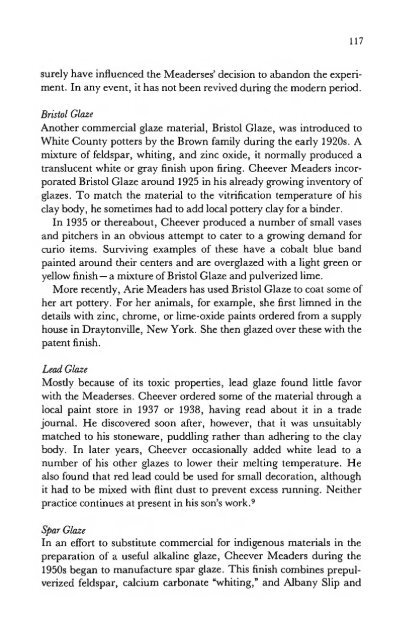Smithsonian Contributions - Smithsonian Institution Libraries
Smithsonian Contributions - Smithsonian Institution Libraries
Smithsonian Contributions - Smithsonian Institution Libraries
Create successful ePaper yourself
Turn your PDF publications into a flip-book with our unique Google optimized e-Paper software.
surely have influenced the Meaderses' decision to abandon the experiment.<br />
In any event, it has not been revived during the modern period.<br />
117<br />
Bristol Glaze<br />
Another commercial glaze material, Bristol Glaze, was introduced to<br />
White County potters by die Brown family during the early 1920s. A<br />
mixture of feldspar, whiting, and zinc oxide, it normally produced a<br />
translucent white or gray finish upon firing. Cheever Meaders incorporated<br />
Bristol Glaze around 1925 in his already growing inventory of<br />
glazes. To match the material to the vitrification temperature of his<br />
clay body, he sometimes had to add local pottery clay for a binder.<br />
In 1935 or diereabout, Cheever produced a number of small vases<br />
and pitchers in an obvious attempt to cater to a growing demand for<br />
curio items. Surviving examples of these have a cobalt blue band<br />
painted around dieir centers and are overglazed with a light green or<br />
yellow finish— a mixture of Bristol Glaze and pulverized lime.<br />
More recendy, Arie Meaders has used Bristol Glaze to coat some of<br />
her art pottery. For her animals, for example, she first limned in die<br />
details with zinc, chrome, or lime-oxide paints ordered from a supply<br />
house in Draytonville, New York. She then glazed over these with the<br />
patent finish.<br />
Lead Glaze<br />
Mosdy because of its toxic properties, lead glaze found little favor<br />
wim the Meaderses. Cheever ordered some of the material through a<br />
local paint store in 1937 or 1938, having read about it in a trade<br />
journal. He discovered soon after, however, diat it was unsuitably<br />
matched to his stoneware, puddling radier dian adhering to the clay<br />
body. In later years, Cheever occasionally added white lead to a<br />
number of his other glazes to lower their melting temperature. He<br />
also found that red lead could be used for small decoration, although<br />
it had to be mixed widi flint dust to prevent excess running. Neidier<br />
practice continues at present in his son's work. 9<br />
Spar Glaze<br />
In an effort to substitute commercial for indigenous materials in die<br />
preparation of a useful alkaline glaze, Cheever Meaders during the<br />
1950s began to manufacture spar glaze. This finish combines prepulverized<br />
feldspar, calcium carbonate "whiting," and Albany Slip and

















